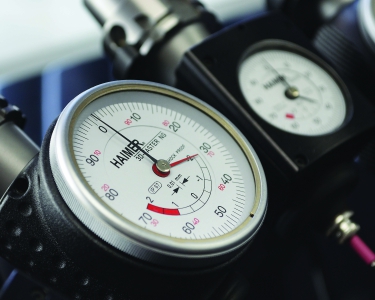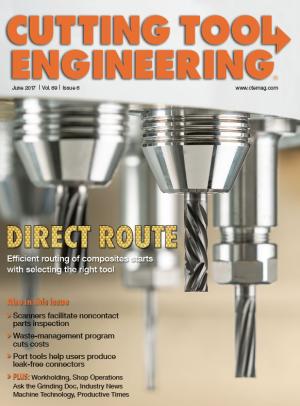Edge finders, center finders and wigglers have been used for decades to touch off workpieces during machine setup. They’re inexpensive and simple to use.
Simply mount one in a machine spindle with a collet or drill chuck, engage the spindle to around 600 rpm, and gently touch the device to the workpiece or vise until the finder end “pops off.” Subtract half the diameter of the finder’s tip to determine the zero position for that axis. Repeat the process in the other axis direction. Aside from finding the top of the workpiece, which is something conventional edge finders cannot do, you’re now ready to make some parts.

Haimer’s 3D-Sensor is a waterproof, shock-resistant measuring device for aligning spindles to workpiece edges and reference edges. Image courtesy of Haimer USA.
Yet some might argue that these old-fashioned devices are a bit too analog for today’s digital world. Drew Strauchen thinks so. The vice president of marketing and business development at Haimer USA LLC, Villa Park, Ill., said the company offers an assortment of 3D-Sensor measuring instruments that not only simplify the edge-finding procedure, but also find the top of the workpiece.
“In addition, a lot of our customers use them to measure parts directly in the machine,” he said.
The setup process is similar except for two things. First, the machine spindle is idle when using a 3D-Sensor. As a result, there’s little risk of inadvertently entering too high of an rpm and watching the edge finder tip go zinging across the shop. Second, because the probe-tip diameter is precalibrated, there’s no chance of scrapping a part because of a math error. (Raise your hand if you’ve ever done this.)
“Visit most any shop in Europe and you’ll find a 3D-Sensor on each CNC machine tool,” Strauchen said. “Machinists start using them in trade school and carry that practice forward after graduation.”
Strauchen added that the instruments are catching on in the U.S. “People find them on our website or hear about them from another shop,” he noted, “and once they start using one, they fall in love with it.”
According to Strauchen, 3D-Sensors save users considerable time and are accurate within 0.0002"(0.005mm). “It’s waterproof and shock-resistant, so you can leave it in the tool magazine,” Strauchen said. “And if you have an accident, the tip is designed to break away without damaging the probe itself.”
Strauchen said four models are available, and the most popular—the Universal 3D-Sensor—sells for around $435, with standard replacement tips selling for $42 or $72 for the extra-long version.
Contact Details
Related Glossary Terms
- chuck
chuck
Workholding device that affixes to a mill, lathe or drill-press spindle. It holds a tool or workpiece by one end, allowing it to be rotated. May also be fitted to the machine table to hold a workpiece. Two or more adjustable jaws actually hold the tool or part. May be actuated manually, pneumatically, hydraulically or electrically. See collet.
- collet
collet
Flexible-sided device that secures a tool or workpiece. Similar in function to a chuck, but can accommodate only a narrow size range. Typically provides greater gripping force and precision than a chuck. See chuck.
- computer numerical control ( CNC)
computer numerical control ( CNC)
Microprocessor-based controller dedicated to a machine tool that permits the creation or modification of parts. Programmed numerical control activates the machine’s servos and spindle drives and controls the various machining operations. See DNC, direct numerical control; NC, numerical control.
- edge finder
edge finder
Gage mounted in the spindle of a vertical mill and used, while rotating, to find the center of a part relative to the toolholder.



